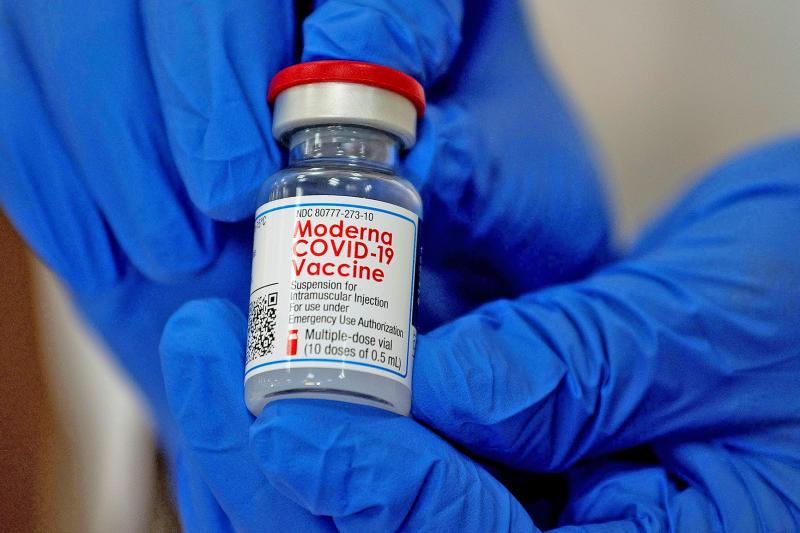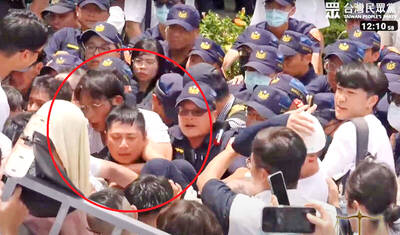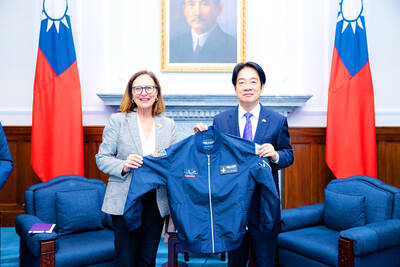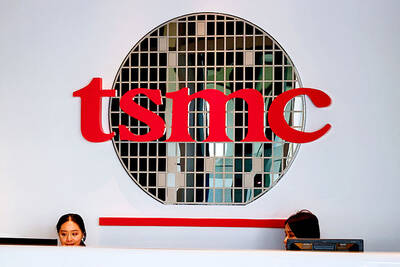US biotechnology company Moderna Inc, one of the two leading makers of mRNA vaccines for COVID-19, on Tuesday announced that it would establish four subsidiaries in Taiwan, Hong Kong, Malaysia and Singapore to support delivery of its vaccines and therapeutics.
The subsidiary in Taiwan is expected to be set up by the end of this year, Moderna told Chinese-language media, adding that it would recruit local talent and collaborate with local hospitals on clinical trials.
Moderna has signed a contract with Taiwan to offer 20 million COVID-19 vaccine and booster doses this year, and another 15 million next year, the company said in a statement.

Photo: Reuters
In Taiwan, its COVID-19 vaccine has been approved for people aged 18 or older, while its booster shots can be given to those who had their second dose five months prior, it said.
Moderna provides Taiwan with its mRNA-1273 vaccine, which targets variants of SARS-CoV-2, and it is developing a next-generation vaccine that it expects to launch in the second half of this year, pending regulatory approval, Moderna senior vice president Patrick Bergstedt said in an interview with the Chinese-language United Daily News.
“This is why we set up a subsidiary in Taiwan — we hope to cooperate with local hospitals and regulators directly so that we could provide our vaccine,” United Daily News quoted Bergstedt as saying.
More studies are required to determine whether booster shots should be given once every six months or once a year, he said.
Moderna did not say whether it would consider manufacturing its COVID-19 vaccine in Taiwan, but the Central News Agency (CNA) yesterday reported that the government is attempting to arrange a technology transfer for the vaccine.
To facilitate a transfer, the government plans to set up a new company in which the National Development Fund would hold a stake of less than 49 percent and the remaining shares would belong to private companies, CNA reported.
South Korea’s Samsung Biologics Co has since May last year been assigned the fill and finish manufacturing task for Moderna’s COVID-19 vaccines, corporate data showed.
Minister of Health and Welfare Chen Shih-chung (陳時中) last year told lawmakers that the US is protective of its mRNA technology, so there would be a higher chance of Taiwan participating in the back-end manufacturing processes, such as fill and finish — the process of filling vials with vaccine and finishing the process of packaging the medicine — than in core manufacturing.
However, Taiwan would strive to transfer the technology, he said.
Asked whether Moderna’s decision to set up a branch in Taiwan could lead to the company’s vaccines being produced in Taiwan or other types of cooperation, Chen yesterday said that the ministry does not know the company’s development plans, but welcomes it to Taiwan and would not exclude the possibility of further cooperation.
Moderna said that the addition of the four subsidiaries comes as it continues to scale up the manufacturing and distribution of its COVID-19 vaccine, and future mRNA vaccines and therapeutics.
The Asia-Pacific region represents an integral part of Moderna’s business, with established subsidiaries in Australia, South Korea and Japan, it said.
Additional reporting by Lee I-chia

TPP RALLY: The clashes occurred near the Chiang Kai-shek Memorial Hall on Saturday at a rally to mark the anniversary of a raid on former TPP chairman Ko Wen-je People who clashed with police at a Taiwan People’s Party (TPP) rally in Taipei on Saturday would be referred to prosecutors for investigation, said the Ministry of the Interior, which oversees the National Police Agency. Taipei police had collected evidence of obstruction of public officials and coercion by “disorderly” demonstrators, as well as contraventions of the Assembly and Parade Act (集會遊行法), the ministry said in a statement on Sunday. It added that amid the “severe pushing and jostling” by some demonstrators, eight police officers were injured, including one who was sent to hospital after losing consciousness, allegedly due to heat stroke. The Taipei

NO LIVERPOOL TRIP: Taiwan’s Lin Yu-ting, who won a gold medal in the boxing at the Paris Olympics, was embroiled in controversy about her gender at that event Taiwanese boxer Lin Yu-ting (林郁婷) will not attend this year’s World Boxing Championships in Liverpool, England, due to a lack of response regarding her sex tests from the organizer, World Boxing. The national boxing association on Monday said that it had submitted all required tests to World Boxing, but had not received a response as of Monday, the departure day for the championships. It said the decision for Lin to skip the championships was made to protect its athletes, ensuring they would not travel to the UK without a guarantee of participation. Lin, who won a gold medal in the women’s 57kg boxing

‘NOT ALONE’: A Taiwan Strait war would disrupt global trade routes, and could spark a worldwide crisis, so a powerful US presence is needed as a deterrence, a US senator said US Senator Deb Fischer on Thursday urged her colleagues in the US Congress to deepen Washington’s cooperation with Taiwan and other Indo-Pacific partners to contain the global security threat from China. Fischer and other lawmakers recently returned from an official trip to the Indo-Pacific region, where they toured US military bases in Hawaii and Guam, and visited leaders, including President William Lai (賴清德). The trip underscored the reality that the world is undergoing turmoil, and maintaining a free and open Indo-Pacific region is crucial to the security interests of the US and its partners, she said. Her visit to Taiwan demonstrated ways the

The US has revoked Taiwan Semiconductor Manufacturing Co’s (TSMC, 台積電) authorization to freely ship essential gear to its main Chinese chipmaking base, potentially curtailing its production capabilities at that older-generation facility. American officials recently informed TSMC of their decision to end the Taiwanese chipmaker’s so-called validated end user (VEU) status for its Nanjing site. The action mirrors steps the US took to revoke VEU designations for China facilities owned by Samsung Electronics Co and SK Hynix Inc. The waivers are set to expire in about four months. “TSMC has received notification from the US Government that our VEU authorization for TSMC Nanjing